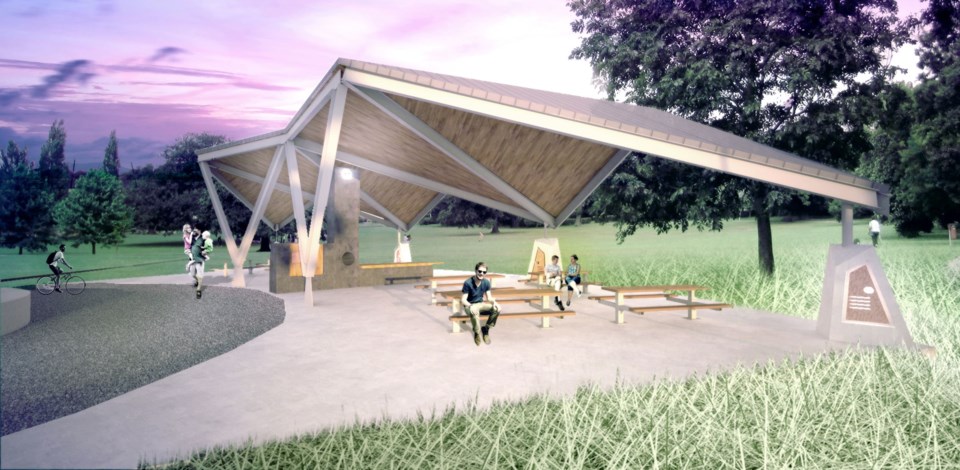A new pavilion will replace the now long-gone shelter that once covered the picnic area at Lheidli T'enneh Memorial Park.
An artist's rendition was unveiled Friday during a media event at the location. It consists of a wood canopy supported by a steel scaffolding sitting on concrete struts and features a monument nestled underneath.
Architect Bruce Carscadden looked around him for the inspiration.
He said the pavilion's peaked roof makes reference to the escarpment on the other side of the Fraser River and it opens broadly to the park's centre. The slight curve in the plan is an ode to the confluence of the Nechako and Fraser.
"We've used materials in a kind of way we think are hip and modern, in the same way your Wood Innovation and Design Centre has and I think it's a really nice structure," Carscadden said.
The monument "harkens to a fireplace" and provides a wheelchair-accessible table. It will also house the utilities "because you need to hide that stuff within some element in the otherwise open structure."
The city has budgeted $779,000 for the project. The federal government is contributing $377,000 through the Canada 150 community infrastructure program and the city is providing a matching amount. The provincial government is covering the monument's $25,000 cost.
A call for competitive bids to build the pavilion will be issued next month and the aim is to have the project completed during this year's construction season. The work should take 3-4 months, Carscadden said.
The unveiling comes 20 months after Fort George Park was renamed Lheidli T'enneh Memorial Park to acknowledge the area's aboriginal roots.
The park was the site of a Lheidli T'enneh village destroyed in a 1913 fire set to ensure the sale of the reserve would go through unimpeded.
A marked cemetery is all that remains of the original village, though artifacts and human remains are still buried beneath the grass throughout the entire site.
Lheidli T'enneh Chief Dominic Frederick emphasized the future when asked if the developments mark a turning point in the relationship between the First Nation and the city.
"We've been working on it and working on it for a long time and that's all part of it," he said. "I think it's better to build the relationship than to be angry about something that happened in the past.
"We have to move on, but the recognition of what has happened has been brought to light - the recognition that we were here and our ancestors had lived here and that's where the village was.
"That's all part of the history of Lheidli T'enneh and where they come from."
Mayor Lyn Hall said the project will answer a long-standing call for a new shelter after the old one was torn down due to safety concerns. A replacement worth $400,000 - with the city convering the entire cost - had been considered during last year's budget talks but was put on hold to give time to consult with Lheidli T'enneh.
"We had a shelter here before and it was utilized a lot," Hall said. "And then when we had to take it down, we heard loud and clear 'we would really like you to rebuild something because we missed the shelter.'"
He expects it will be used extensively and not just for picnics but also for "weddings, celebrations, receptions, multiple uses."
"We're putting back what we had, but only better," Hall said.
Click here for a video artist's rendering of the structure.



